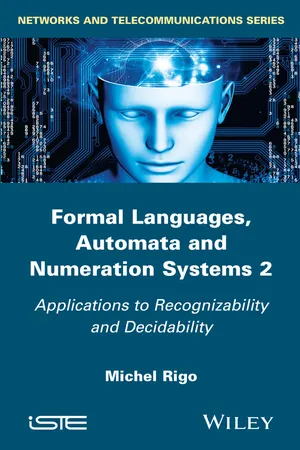
Formal Languages, Automata and Numeration Systems 2
Applications to Recognizability and Decidability
- English
- ePUB (mobile friendly)
- Available on iOS & Android
Formal Languages, Automata and Numeration Systems 2
Applications to Recognizability and Decidability
About This Book
The interplay between words, computability, algebra and arithmetic has now proved its relevance and fruitfulness. Indeed, the cross-fertilization between formal logic and finite automata (such as that initiated by J.R. Büchi) or between combinatorics on words and number theory has paved the way to recent dramatic developments, for example, the transcendence results for the real numbers having a "simple" binary expansion, by B. Adamczewski and Y. Bugeaud.
This book is at the heart of this interplay through a unified exposition. Objects are considered with a perspective that comes both from theoretical computer science and mathematics. Theoretical computer science offers here topics such as decision problems and recognizability issues, whereas mathematics offers concepts such as discrete dynamical systems.
The main goal is to give a quick access, for students and researchers in mathematics or computer science, to actual research topics at the intersection between automata and formal language theory, number theory and combinatorics on words.
The second of two volumes on this subject, this book covers regular languages, numeration systems, formal methods applied to decidability issues about infinite words and sets of numbers.
Frequently asked questions
Information
1
Crash Course on Regular Languages
1.1. Automata and regular languages

Table of contents
- Cover
- Contents
- Dedication
- Title Page
- Copyright
- Foreword
- Introduction
- 1 Crash Course on Regular Languages
- 2 A Range of Numeration Systems
- 3 Logical Framework and Decidability Issues
- 4 List of Sequences
- Bibliography
- Index
- Summary of Volume 1